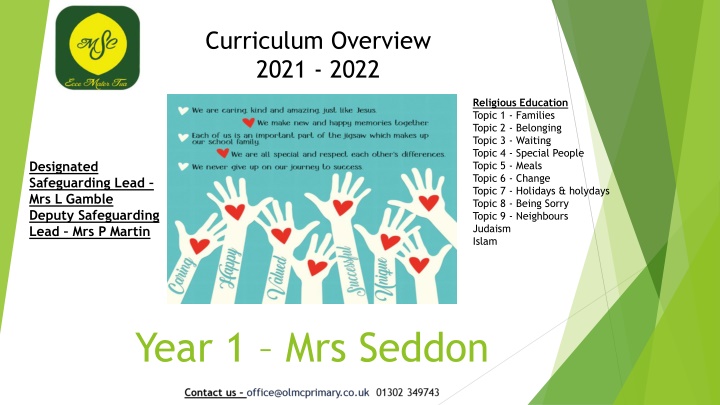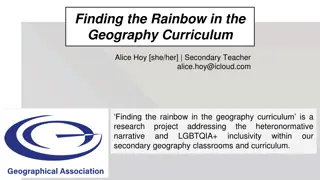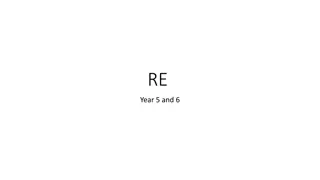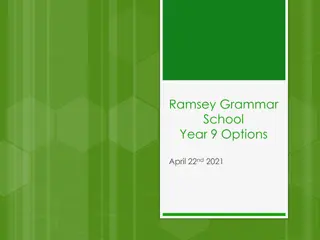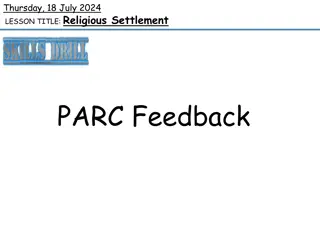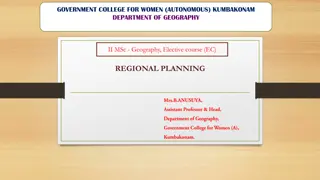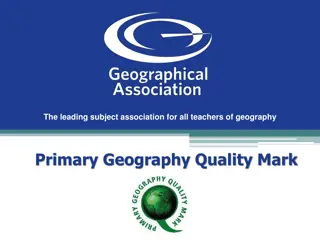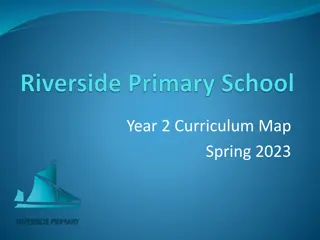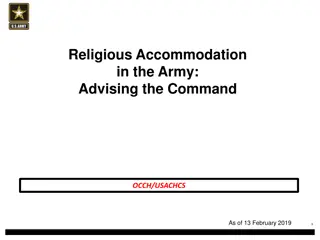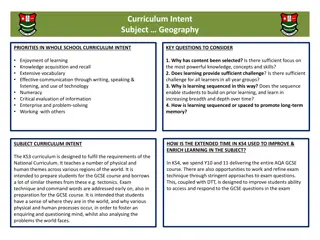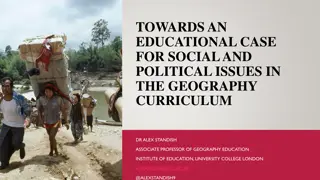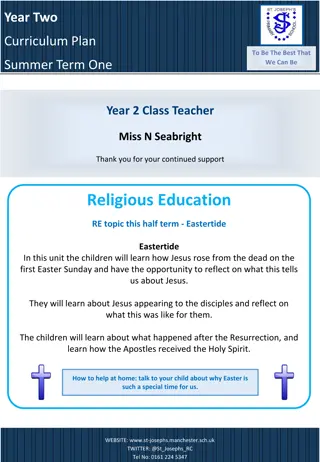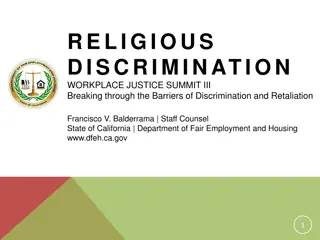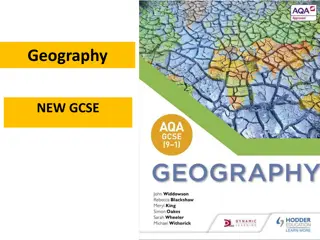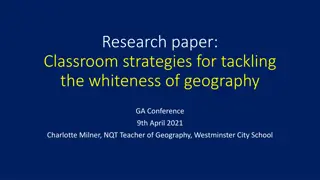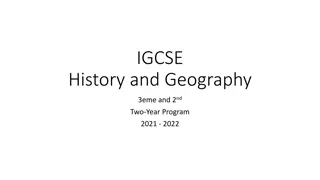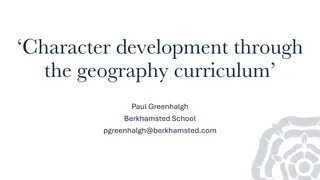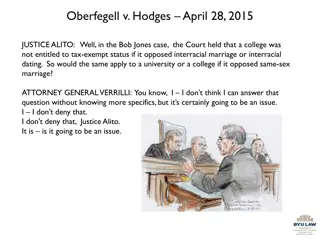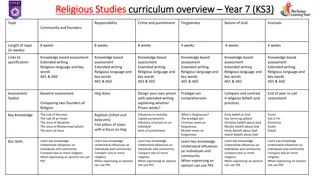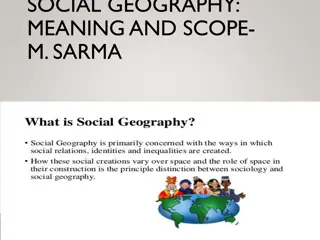2021-2022 Curriculum: Religious Education and Geography Focus in Year 1
Delve into the diverse topics covered in the 2021-2022 curriculum, including Religious Education themes such as Families, Belonging, and Holidays, as well as a detailed exploration of Geography focusing on England, Northern Ireland, and Scotland. Engage in educational activities related to the Great Fire of London, learning about historical events and key figures while discovering the iconic landmarks and significant changes that have shaped these regions.
Download Presentation

Please find below an Image/Link to download the presentation.
The content on the website is provided AS IS for your information and personal use only. It may not be sold, licensed, or shared on other websites without obtaining consent from the author.If you encounter any issues during the download, it is possible that the publisher has removed the file from their server.
You are allowed to download the files provided on this website for personal or commercial use, subject to the condition that they are used lawfully. All files are the property of their respective owners.
The content on the website is provided AS IS for your information and personal use only. It may not be sold, licensed, or shared on other websites without obtaining consent from the author.
E N D
Presentation Transcript
Curriculum Overview 2021 - 2022 Religious Education Topic 1 - Families Topic 2 - Belonging Topic 3 - Waiting Topic 4 - Special People Topic 5 - Meals Topic 6 - Change Topic 7 - Holidays & holydays Topic 8 - Being Sorry Topic 9 - Neighbours Judaism Islam Designated Safeguarding Lead Mrs L Gamble Deputy Safeguarding Lead Mrs P Martin Year 1 Mrs Seddon
Vocabulary: Geography England Northern Ireland Scotland Wales union United Kingdom England - London Buckingham Palace Houses of Parliament River Thames city countryside Saint George Scotland - islands kilt bagpipes thistle Caledonia Britannia Loch Ness Grampian Mountains Hadrian s Wall Edinburgh History Past, present, modern, old, change, chimney sweep, carpenter, farmer, rat-catcher, Great Fire, London, burning, escaping, spreading, River Thames, diary, Samuel Pepys, Pudding Lane, materials, King Charles II, smoke, baker, bakery, ashes, Christopher Wren, city, destroyed, disaster, dry, emergency, exploded, fire hook, fire brigade, leather bucket, John Evelyn, memorial, narrow, wood, stone, brick, design, rebuild, plaster, weather, impact, buildings Art Primary colours, secondary colours, mixing, shade, layer texture, rip tear, silhouette Design and technology Design, make, model, develop, equipment, construct, tools, join, shape, cut, material, draw, build. Science Material, wood, plastic, metal, glass, stone, rubber, sponge, hard, soft, strong, smooth, rough, bend, bouncy Floating and sinking objects variety of recycled materials. AUTUMN TERM IN YEAR 1 Educational Visit - Great Fire of London Day Key texts: Recounts; Adventure Narrative; Instructions; Character Study; Captions Rationale: To know countries and capital cities of the UK, using locational language, using maps. To discover the city of London with its famous and varied buildings and landmarks and the Queen ! But did London always look like the modern-day London we see today? To know that the fire started on 2nd September 1666 and burned for 3 days. That the fire is thought to have started in Pudding Lane, London. To name other landmarks in London (including River Thames, Tower of London, St Paul s Cathedral, the city wall) and be able to discuss how they were affected by, or altered, the course of the fire. To name key people alive in 1666 (including Thomas Farriner, King Charles II, Samuel Pepys/John Evelyn) and what part they played in the events. To discuss how the fire could have started and what factors made it spread. To discuss the effects of the fire on the City of London and the impact it had on the people who lived and worked there. To compare and contrast London before and after the fire. To discuss the development of firefighting as a consequence of the fire. Put on your best outfit because you re invited to have tea with the Queen! What do you know about England s capital city? Let s find out all about London, including its history, transport and famous landmarks. Step back in time and discover what happened in the Great Fire of London. Where did it start? How did it end? Fire, Fire! Role Play London street Help your child prepare Why not visit a local city to spot interesting vehicles, buildings and landmarks? Alternatively, you could search the web for images, information and film clips about London and keep a scrapbook of your findings. You could also visit the local library to see if you can find some colourful books of nursery rhymes and traditional songs to enjoy together.
SPRING TERM IN YEAR 1 Role Play Woodland cabin Reading Area Large tree trunk for the children to read inside the tree trunk Story characters Woodland stories Vocabulary: Science Senses eyes, sight, see, ears, hear, listen, taste, tongue (sweet, sour, bitter, salt), touch, feel (soft, hard, rough, smooth, bumpy), nose, smell. Plants - seed, leaves, stem, root, flower, bud, plant, leaf, grow, weed, change, living, water, healthy, similar to, different from potato, chitting, pollen, flower plant, leaf, grow, deciduous, evergreen, leaves, flower, trunk, bark Art and design Artist, sculpture, model, natural object, materials, natural materials, base, man made, natural, draw, sketch, observe, inspiration, exhibition Key texts: Jack and the Bean Stalk Little Red Riding Hood Hansel and Gretel Prickly Hedgehogs! by Jane Mc Guinness The Winter Hedgehog by Anne Cartwright Night Animals by Susan Meredith One Snowy Night by Nick Butterworth Visits Rationale: The topic will start by the children investigating their senses. Once the children have a good understand of their 5 sense s they can use this knowledge to investigate the other scientific areas- planting/animal/seasons, support them on their woodland hunt and help them when they are doing their observational drawing/sculpture (Art & Design) After studying dense woods and looking at woodland animals and flowers, the children will have a better understanding of how the characters in the stories, LRRH and Hansel and Gretel felt and saw as they travelled through the woods. What type of flowers would LRRD have picked for her grandmother? Expectations at the end of the topic to develop children s knowledge of British wildlife and woodland habitats. For the year 1 children to observe and identify plants and animals understand seasonal change and appreciate the wonder of the woodland. If you go down to the woods today you re sure of a big surprise! Foxes and badgers, voles and mice, beady-eyed owls in the tree tops. Beneath the leaves are tiny footprints animal or imp? You decide! Let s build a den, stick by stick and branch by branch. Or we could make a teeny tiny home for a woodland fairy. Help your child prepare Woodlands are interesting places. Why not take a woodland walk and see which plants and creatures you can find? Simple spotting books or apps will help you to identify unknown species. Alternatively, visit the local library and borrow information and storybooks about woodland creatures to read together. You could also collect twigs, leaves, seed cases and flowers to make natural art together outside. Remember to take photos before the wind blows your artwork away!
Vocabulary: Geography - Earth Globe Asia Europe Africa North America South America Australia Antarctica Pacific Atlantic Indian Southern Arctic North Pole South Pole Antarctica tilt orbit summer winter Africa equator desert grassland jungle Asia tropical rainforest monsoon drought Great Wall of China Pacific Ocean Indian Ocean North America South America Panama Canal Statue of Liberty Amazon Rainforest Niagara Falls History explorer, Christopher Columbus, discovery Science - fish, amphibians, reptiles, birds and mammals, ocean, habitats, environment, Art and design Collage, artist, Jane Perkins SUMMER TERM IN YEAR 1 Key texts: Snail and the whale Rainbow fish Tiddler Julia Donaldson Sharing a shell by Julia Donaldson Commotion in the ocean Under the Sea Take a journey to the deepest depths of the oceans as we dive into life underwater with this fantastic topic! Discover weird and wonderful sea creatures, explore major oceans and seas of the world and get creative with some fishy art! mermaids/mermen/sea creatures and underwater print using paint and bubble wrap Marbling to create seascapes Let's design and make boats. Will they float or will they sink? Rationale: To research under sea creatures and marine life. Find out about all the beautiful sea creatures the unusual plants and the coral reefs that provide homes to the countless creatures. We will discover that many sea creatures can live close to the ocean's surface but can also live down in the dark abyss of the ocean floor. Together, we will find out about the sea food chain and what sharks and dolphins have for dinner! We will discover and understand about the importance of our oceans and seas and to think about what we can do to protect them and keep them clean and healthy. We will our imagination to design new patterns for a fish, create a collage of Help your child prepare Why not search the web for images, information and film clips about the sea and keep a scrapbook of your findings. You could also visit the local library to see if you can find some colourful books of nursery rhymes and traditional songs to enjoy together.
Year 1 - Autumn - Block 1 Place Value Sort objects Count objects Represent objects Count forwards/ backwards Count one more/ one less One to one correspondence Compare objects Introduce <, > and = Compare numbers Order objects/ numbers The number line Year 1 - Autumn Block 3 - Shape Recognise and name 3-D shapes Sort 3-D shapes Recognise and name 2-D shapes Sort 2-D shapes Patterns with 3-D and 2-D shapes Year 1 - Autumn Block 4 - Place Value (within 20) Count forwards and backwards and write numbers to 20 in numerals and words Numbers from 11 to 20 Tens and ones Count one more and one less Compare groups of objects Compare numbers Order groups of objects Order numbers Year 1 - Autumn Block 2 - Addition & Subtraction Part-whole model Addition symbol Fact families - addition facts Find number bonds for numbers within 10 Systematic methods for number bonds within 10 Number bonds to 10 Compare number bonds Addition and Subtraction Fact families - the 8 facts Comparing addition and subtraction statements
Year 1 - Spring Block 1 - Addition & Subtraction Add by counting on Find & make number bonds Add by making 10 Subtraction - not crossing 10 Subtraction - crossing 10 Related facts Compare number sentences Year 1 - Spring Block 3 - Length & Height Compare lengths & heights Measure length Adding length problems Subtracting length problems Year 1 - Spring Block 2 - Place Value (within 50) Numbers to 50 Counting forwards and backwards within 50 Tens and ones Represent numbers to 50 One more one less Compare objects within 50 Order numbers within 50 Count in 2s Count in 5s Year 1 - Spring Block 4 - Weight & Volume Introduce weight & mass Measure mass Compare mass Weight and mass problems Introduce capacity and volume Measure capacity Compare capacity
Year 1 - Summer Block 4 - Place Value (within 100) Counting to 100 Counting forwards and backwards within 100 Partitioning numbers Comparing numbers (1) Ordering numbers One more, one less Year 1 - Summer Block 1 - Multiplication & Division Recap Count in 2s and 5s Count in 10s Make equal groups Add equal groups Make arrays Make doubles Make equal groups grouping/sharing Year 1 - Summer Block 5 - Money Recognising coins Recognising notes Counting in coins Year 1 - Summer Block 2 - Fractions Find a half Find a quarter Year 1 - Summer Block 3 - Position & Direction Describe turns Describe position (1) Year 1 - Summer Block 6 - Time Before and after Dates Time to the hour Time to the half hour Writing time Comparing time
OLMC VALUES Happy Caring Valued Unique Successful OLMC GOLDEN RULES 1. We show respect 2. We are gentle, kind and helpful 3. We have good manners 4. We are honest 5. We work hard 1. 2. 3. 4. 5. If I am successful Dojo points Class Rewards If I am not successful, the consequences will be Stand with an adult at breaktime or lunchtime Remove from special activities Remove from lunchtime activity Contact parents For with God nothing is impossible. Luke 1:37
